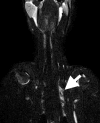Magnetic resonance imaging findings in dogs with steroid-responsive meningitis-arteritis in the UK and their clinical significance: 53 cases (2013-2021)
- PMID: 39228252
- PMCID: PMC11736089
- DOI: 10.1111/jsap.13775
Magnetic resonance imaging findings in dogs with steroid-responsive meningitis-arteritis in the UK and their clinical significance: 53 cases (2013-2021)
Abstract
Objectives: To describe the MRI findings in a UK referral population of dogs with steroid-responsive meningitis-arteritis and to determine if they were associated with any specific clinical features or outcomes.
Materials and methods: We performed a multi-centre retrospective case series of dogs diagnosed with steroid-responsive meningitis-arteritis in the UK that underwent MRI. Blinded consensus review of the MRI studies was performed and the findings described. The presence or absence of specific MRI abnormalities were analysed for significant associations with presenting signs, results of investigations or case outcomes.
Results: Fifty-three dogs were included. The most common MRI findings were paravertebral muscle changes (30/53; 56.6%), meningeal contrast enhancement (13/41; 31.7%) and spinal cord parenchymal T2-W hyperintensity (15/53; 28.3%). Haemorrhage was observed in five of 53 (9.4%) cases - three intradural-extramedullary, one intramedullary and one extradural. Following binary logistic regressions, T2-W spinal cord parenchymal hyperintensity had a significant positive association with paresis/paralysis (odds ratio 14.86, 95% confidence interval 1.42 to 154.99) as did haemorrhage (odds ratio 16.12, confidence interval 2.05 to 126.73). Fifty-two (98.1%) dogs survived to discharge. Relapse occurred in nine of 29 (31.0%) dogs with sufficient follow-up, and no MRI finding had a significant relationship with its occurrence.
Clinical significance: Magnetic resonance imaging findings for steroid-responsive meningitis-arteritis can be severe and extensive, as can the clinical presentation. The presence of paresis/paralysis should raise concern for haemorrhage, though most dogs still have a good prognosis.
© 2024 Linnaeus, Pride Veterinary Referrals and The Author(s). Journal of Small Animal Practice published by John Wiley & Sons Ltd on behalf of British Small Animal Veterinary Association.
Conflict of interest statement
None of the authors of this article has a financial or personal relationship with other people or organisations that could inappropriately influence or bias the content of the paper.
Figures



Similar articles
-
Epistaxis and Intradural-Extramedullary Haemorrhage in a Dog With Steroid Responsive Meningitis-Arteritis.Vet Med Sci. 2025 Jan;11(1):e70148. doi: 10.1002/vms3.70148. Vet Med Sci. 2025. PMID: 39749791 Free PMC article.
-
Association between steroid-responsive meningitis-arteritis and gastrointestinal signs in dogs: a case-control study.J Am Vet Med Assoc. 2025 May 21;263(9):1-6. doi: 10.2460/javma.25.02.0119. Print 2025 Sep 1. J Am Vet Med Assoc. 2025. PMID: 40398465
-
Signs and symptoms to determine if a patient presenting in primary care or hospital outpatient settings has COVID-19.Cochrane Database Syst Rev. 2022 May 20;5(5):CD013665. doi: 10.1002/14651858.CD013665.pub3. Cochrane Database Syst Rev. 2022. PMID: 35593186 Free PMC article.
-
Cost-effectiveness of using prognostic information to select women with breast cancer for adjuvant systemic therapy.Health Technol Assess. 2006 Sep;10(34):iii-iv, ix-xi, 1-204. doi: 10.3310/hta10340. Health Technol Assess. 2006. PMID: 16959170
-
A rapid and systematic review of the clinical effectiveness and cost-effectiveness of topotecan for ovarian cancer.Health Technol Assess. 2001;5(28):1-110. doi: 10.3310/hta5280. Health Technol Assess. 2001. PMID: 11701100
Cited by
-
Clinical Features, MRI Findings, Treatment, and Outcomes in Dogs with Haemorrhagic Myelopathy Secondary to Steroid-Responsive Meningitis-Arteritis: Nine Cases (2017-2024).Vet Sci. 2025 May 15;12(5):476. doi: 10.3390/vetsci12050476. Vet Sci. 2025. PMID: 40431569 Free PMC article.
-
Hemorrhagic encephalopathies and myelopathies in dogs and cats: a focus on classification.Front Vet Sci. 2024 Oct 28;11:1460568. doi: 10.3389/fvets.2024.1460568. eCollection 2024. Front Vet Sci. 2024. PMID: 39529855 Free PMC article. Review.
References
-
- Bathen‐Noethen, A. , Carlson, R. , Menzel, D. , Mischke, R. & Tipold, A. (2008) Concentrations of acute‐phase proteins in dogs with steroid responsive meningitis‐arteritis. Journal of Veterinary Internal Medicine, 22, 1149–1156. - PubMed
-
- Biedermann, E. , Tipold, A. & Flegel, T. (2016) Relapses in dogs with steroid‐responsive meningitis‐arteritis. The Journal of Small Animal Practice, 57, 91–95. - PubMed
-
- Brocal, J. , José López, R. , Hammond, G. & Gutierrez‐Quintana, R. (2017) Intracerebral haemorrhage in a dog with steroid‐responsive meningitis arteritis. Veterinary Record Case Reports, 5, e000436.
-
- Cizinauskas, S. , Jaggy, A. & Tipold, A. (2000) Long‐term treatment of dogs with steroid‐responsive meningitis‐arteritis: clinical, laboratory and therapeutic resuIts. The Journal of Small Animal Practice, 41, 295–301. - PubMed
Publication types
MeSH terms
Substances
LinkOut - more resources
Full Text Sources
Medical

